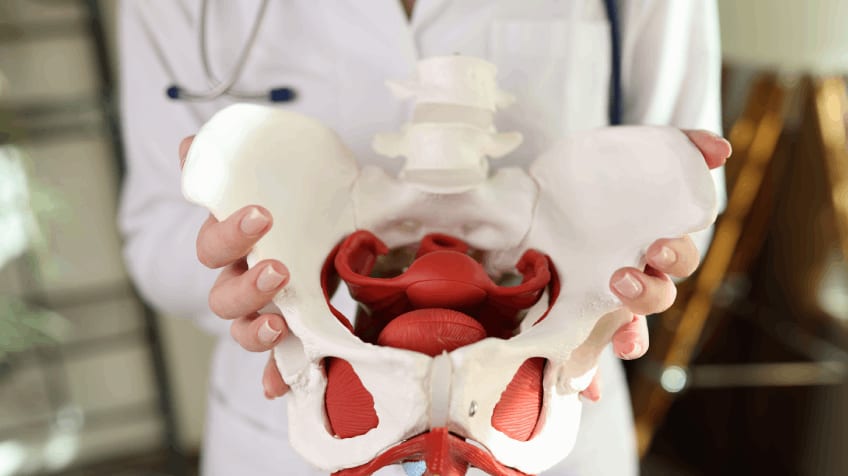Hello everyone, I am Dr. Madhu Juneja, Director of Obstetrics and IVF at Momstory, Pune.
Today, let’s talk about a common condition many women experience in the later stages of pregnancy—Pelvic Girdle Pain (PGP), also known as Symphysis Pubis Dysfunction (SPD).
Many pregnant women often come to us saying, “Doctor, I feel pain in the front vaginal area”—especially during the eighth or ninth month. While this pain is usually normal, it can be uncomfortable and sometimes alarming. The good news is, with the right care, exercises, and lifestyle adjustments, it can be managed effectively.
What is Pelvic Girdle Pain (PGP)?
Pelvic Girdle Pain refers to discomfort or pain around the pubic symphysis—the joint at the front of your pelvis. This happens because, during pregnancy, your body produces a hormone called Relaxin, which loosens your joints and ligaments to prepare for childbirth.
While this is essential for an easier delivery, the pelvic joints may become unstable, leading to pain in the front pelvic region, lower back, and hips.
Common Symptoms of Pelvic Girdle Pain
-
Sharp or shooting pain in the front vaginal/pubic area
-
Pain that worsens while getting out of bed, walking, or turning
-
A “clicking” or “grinding” feeling in the pelvis
-
Discomfort while climbing stairs or standing on one leg
-
Sudden pain while changing positions
These symptoms can interfere with daily activities, but they can be managed with proper guidance.
Why Does PGP Happen in Pregnancy?
-
Hormonal Changes – The hormone Relaxin loosens pelvic joints for delivery.
-
Increased Body Weight – Extra weight puts strain on hip and pelvic muscles.
-
Postural Imbalance – As your belly grows, posture shifts, leading to added pressure.
-
Physical Strain – Lifting toddlers, bending incorrectly, or sudden movements can worsen the pain.
How to Prevent and Manage Pelvic Girdle Pain
1. Safe Movements in Daily Life
-
While getting out of bed or car, keep your legs together and slide out slowly (placing a plastic bag beneath can make movement easier).
-
Always sit down while dressing, instead of standing on one leg.
-
Avoid carrying heavy loads, including lifting older children during late pregnancy. Instead, ask them to climb onto a stool and hug them in your lap.
2. Physiotherapy and Exercises
Physiotherapy plays a vital role in reducing pelvic girdle pain.
-
Posture correction exercises can balance the pelvis.
-
Strengthening routines support pelvic ligaments.
-
Aqua therapy, aqua yoga, or walking in a swimming pool helps relieve pressure due to water resistance, reducing pelvic pain.
3. Supportive Aids
-
Wearing a pelvic support belt or maternity girdle can provide additional stability.
-
However, these should not replace exercises—belts are supportive tools, not solutions by themselves.
4. Nutrition and Supplements
Balanced nutrition is key for bone and joint health during pregnancy:
-
Increase Vitamin D and Calcium intake for bone strength.
-
Include anti-inflammatory foods to reduce swelling and discomfort.
-
If recommended by your doctor, short-term supplements or mild medications may help ease inflammation and pain.
Is Pelvic Girdle Pain Normal?
Yes, pelvic girdle pain is common and manageable.
It does not indicate a complication but rather a natural part of pregnancy as your body prepares for childbirth. Women who are tall or have a heavier build may notice it more, but it can affect any pregnant woman.
With proper physiotherapy, safe exercises, and supportive care, you can continue your pregnancy comfortably.
When to See a Doctor
If the pain becomes severe, prevents walking, or is associated with swelling, always consult your gynecologist. Early guidance ensures better management and prevents unnecessary stress.
Why Choose Momstory Pune for Pregnancy Care?
At Momstory, Pune, we provide:
-
Expert gynecologist and physiotherapist consultations
-
Safe prenatal physiotherapy programs
-
Personalized care for pregnancy-related discomforts
-
A holistic approach to ensure both mother and baby remain healthy
Final Thoughts
Pelvic Girdle Pain (PGP) may feel overwhelming in the later stages of pregnancy, but remember—it is normal, temporary, and treatable. By following the right posture techniques, doing physiotherapy, maintaining proper nutrition, and seeking timely medical advice, you can manage this condition effectively.
At Momstory, Hadapsar (Pune), we are here to guide you every step of the way in your pregnancy journey.

